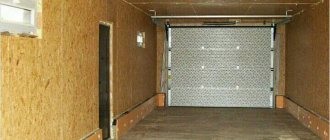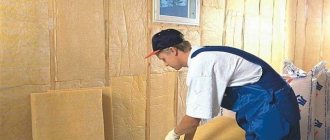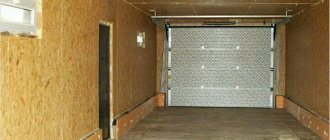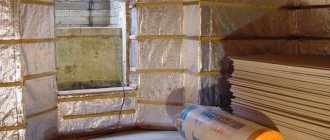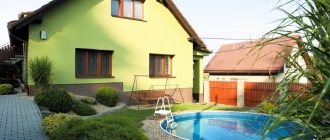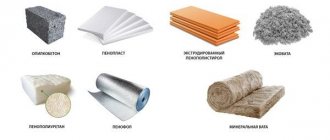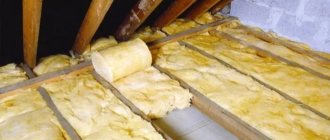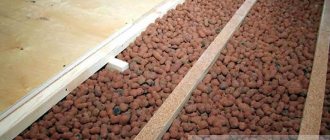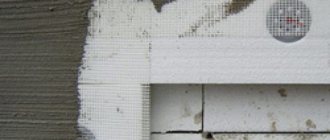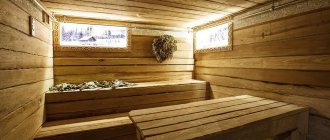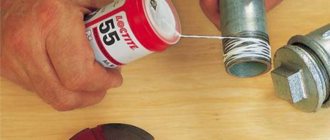By laying insulation under drywall, you can achieve the solution of several problems at the same time - providing optimal thermal insulation, leveling the walls and performing sound insulation.
If there is a need to build several additional partitions in an apartment or house, then it is cheaper and faster to build them using plasterboard, and insulating partitions from plasterboard will provide additional warmth and sound insulation.
Application of new developments
Competition in the construction market forces manufacturers to look for ways to improve product quality. To achieve this, work is being done in the following directions:
- creation of acoustic drywall;
- use of special filler with noise-absorbing properties for partitions;
- elastic pads under the frame, reducing the sound of impacts;
- filling partitions and creating false walls;
- spraying cellulose fibers inside partitions.
Acoustic drywall
and Aku-Line have mastered the production of acoustic plasterboard, which reduces the noise level when finishing interior partitions and when covering walls. Increased sound insulation of the partition is achieved due to a large number of holes, creating a reflection of a passing sound wave directed at the wall surface. In addition, a non-woven fabric is glued to the cardboard on the reverse side, which absorbs sound.
Acoustic plasterboard "Knauf"
Sound-absorbing filler inside partitions
Sound insulation of plasterboard partitions also requires the presence of a sound-absorbing filler between them. The same companies are developing it. Expanded polystyrene is widely used - a foamed thermoplastic made from fused granules with air cavities. The material also successfully copes with the function of thermal insulation. The addition of a fire retardant can increase the fire resistance of polystyrene foam. Judging by customer reviews, domestic polystyrene foam is a very poor thermal insulator.
Mineral wool slabs have high protective properties against sound propagation. produces a wide range of acoustic stone wool slabs, among which 4 cm thick products are often used for soundproofing walls. For effective dispersion of sound waves, the homogeneity of the slabs, which acoustic mats have, is of great importance.
Acoustic mats "Rockwool"
Partition materials with improved soundproofing properties are more expensive than usual, but with their help they achieve complete sound insulation. In addition, you can use filler of a smaller thickness, which will reduce costs and loss of room volume.
Membranes made of thin fabric with a fleecy coating are a high-quality sound absorber. The layer can be from 2.5 to 12 mm thick.
Polyester or polyurethane foam panels are used for internal filling and to create false walls. Some of them may be a fire hazard due to the content of flammable substances.
The cheapest filler for plasterboard walls is polystyrene foam. It reduces noise to some extent, but its efficiency is low.
Spraying sound-absorbing coatings
Spraying cellulose fibers with an adhesive composition is often used due to its low cost and the possibility of mechanizing the process. The method is used to correct acoustics indoors for entertainment and public purposes.
How does cellulose spraying occur?
Ready-made Sonaspray coatings have a texture like fur coat plaster. It can be coarse or uniform, depending on the size of the cellulose flakes. Since the coatings look impressive, dyes of a wide variety of shades are added to the solution. The coating can be painted after it has been applied.
The ability to spray a foamed cellulose solution on the surface of walls and ceilings made of building materials eliminates the need to create a frame that is used to hold gypsum board cladding. The manufacturability and cost-effectiveness of the process allows the team of specialists to ensure a productivity of 300 m² per day.
If you have the necessary equipment, the sound insulation of a plasterboard interior partition can be improved by applying cellulose from the inside.
Thermal insulation properties of plasterboard
The use of plasterboard slabs allows you to create high thermal and sound insulation not only due to the pores that form inside it, but also due to the air layer that is located behind the slab. Therefore, for a relatively warm climate, you may not need to use additional insulation. As for the gypsum board itself, the level of thermal insulation is determined by the thermal conductivity coefficient. For example, drywall has a thermal conductivity coefficient of only 0.15, which is significantly lower than reinforced concrete. This allows you to not only create warmth in the winter, but also coolness in the summer.
It is worth noting that the method of installing drywall affects the level of thermal insulation. To achieve greater effect, it is recommended to use a frame option rather than glue. The resulting layer under the frame creates additional insulation of the walls. But, one way or another, to create a warm atmosphere you will need insulation.
How to choose materials
Previously, before the invention of drywall, sound insulation was achieved by building a heavy brick or concrete wall. But it is obvious that this increases the load on the floor. Even earlier, partitions were made from so-called shingles. This is an interlacing of wooden slats, smeared with clay. This material is fragile and flammable, and the durability of the wall leaves much to be desired, fire safety even more so.
Fortunately, drywall is free from the following disadvantages:
- The material is non-flammable. If you choose a metal frame and mineral wool insulation, then you don’t have to worry about a fire in such a room. Plaster does not burn.
- The weight of one meter of brickwork is almost one and a half tons. A square meter of a single-layer gypsum partition weighs only 50 kg.
- A plasterboard partition is easy and quick to install. You just need to carefully mark everything and follow the instructions.
- The excellent sound insulation of the plasterboard surface in combination with other qualities makes the material the best option for building an interior wall.
The ceiling is both beautiful and protects from noise
Insulation for partitions
Is it possible to use polystyrene foam as insulation for partitions in a wooden house ? Yes, but with some degree of conditionality. Despite the inclusion of non-flammable components in its composition, the non-flammability of the material leaves much to be desired.
And in appearance, ordinary foam plastic and the one that passed the combustion test are no different. When purchasing, you will have to trust the documents accompanying the consignment of goods, or use it inside not wooden, but concrete structures, where the likelihood of fire is lower. GKL partitions have gained popularity due to their ease of installation and low costs for purchasing the necessary building materials. Drywall sheets themselves are considered a good insulation and sound absorber; the air gap between them enhances the effect. Sometimes insulation for gypsum board partitions is not inserted inside - it all depends on the requirements for the construction.
However, this approach is the exception rather than the rule. No one asks why insulate the external walls of the house, ceilings, floors, roofs, but you can hear conflicting opinions about insulation for partitions . Some say that it is not needed, because the heating system is single, and there is no point in isolating one heated room from another. There is a reason in such reasoning, but there are many who want to insulate, for example, a child’s room or bedroom, at the same time adding several additional sections to the radiator. It is more rational to insulate partitions with basalt or fiberglass sheet mineral wool with a density of 35 kg/m³ and a thickness of 50 mm - TECHNONICOL, ROCKWOOL, ISOVER, etc.
For example: TECHNONICOL Rocklight, TECHNONICOL Technolight Optima, TECHNONICOL Technolight extra, ROCKWOOL Superrock, ROCKWOOL Rockmin, ISOVER KL 37. For partitions, it is recommended to take a profile of 50 x 50 mm, 3 m long, along the perimeter - a profile of 50 x 40 mm. Lay a layer of vapor barrier on both sides of the mineral wool insulation in the frame partition.
And yet, polystyrene foam is an excellent budget solution for sound and heat insulation of partitions. To increase fire safety (by the way, polystyrene foam does not burn, but melts), you can stick a façade mesh onto the foam sheets and coat the top with tile adhesive mortar. Polystyrene foam is a popular insulation material for partitions in a frame house (due to its low cost), but another problem awaits here: if mice get into the foam core, it will be difficult to get them out of there.
Penoplex insulation under drywall without frame
Step-by-step instructions will be like this:
- At the first stage, the base surface is prepared: the old coating is removed, cracks and potholes are sealed, and protrusions are knocked down. The wall should be as flat as possible.
- The surface is treated with a deep penetration primer.
- According to the manufacturer's recommendations, a special composition is prepared. If you don't have it, you can use tile adhesive.
- The inside of the insulation board is rolled with a needle roller. Another option is to brush it with a metal brush. This will ensure good adhesion to the adhesive solution.
- A fragment of insulation is applied to the wall and held for a minute. Be sure to check the correct installation at the building level.
- Begin gluing the penoplex from the bottom. It is recommended to move the rows relative to each other so that the slabs are staggered.
- The seams between the plates are filled with silicone sealant; wide cracks can be sealed with polyurethane foam.
- Drywall is attached to the insulation using glue. The scheme for applying the composition is the same as for penoplex slabs. It is recommended to place a layer of vapor barrier between them.
- After the glue has dried, which will take 24 hours, the drywall is finished. The seams are sealed using putty and serpyanka mesh, rubbed down, after which the entire surface is covered with a double layer of primer.
Good advice
- By insulating walls with gypsum, you can avoid the cost of purchasing some building materials. The vapor barrier layer must consist of a special membrane whose density ranges from 90 to 150 micrometers.
- Using hardware, choose a product with a wide head. It will serve as a reliable fixation for the drywall sheet.
- It is not recommended to choose drywall that is too low in cost. Such savings may later result in unscheduled repairs, since the quality of the material may be much lower than expected.
- When insulating a wooden house, you need to place an additional layer of insulation made of non-combustible material between the surface of the wall and the drywall.
- Sheets of material are installed exactly end-to-end, regardless of their thickness. Neglecting this advice may result in the wall surface not being very smooth even under a layer of plaster.
- When using wooden beams as sheathing material, make sure that it is not damaged by insects. It is better to treat the wood with an antiseptic compound before installation.
- The type and dimensions of the material must be in accordance with the purpose of the room where the drywall is installed.
- All corners of the material are secured with special care when laying the insulation. Otherwise, any carelessness will lead to damage to the sheet section.
The basic principles of working with plasterboard when insulating walls in a home from the room side are outlined above. Regardless of the material of the walls of a residential building, thermal insulation and cladding of the wall surface using plasterboard should be carried out as carefully and efficiently as possible. Otherwise, the result will not be able to meet expectations, which threatens premature repair of the plasterboard wall.
Installation of sound-absorbing panels
To assemble and cover the frame you will need the following tools:
- laser level;
- drill;
- screwdriver;
- construction stapler.
- metal profile;
- elastic polymer tape;
- plasterboard (from 12 mm);
- mineral wool slabs (thickness from 100 mm);
- polyethylene film;
- self-tapping screws;
- sealant.
The work is carried out in the following order:
The working principle of sound insulation.
- The walls are marked under a plasterboard frame using a level.
- The profile is placed along the perimeter of the wall surface (or between the walls if a false wall is being built), then guide profiles are attached to it in increments of 40-60 cm, fixing them with self-tapping screws every 60 cm.
- To increase the sound insulation of the walls, an elastic insulating tape is laid along the edges of the frame, which should fit tightly to the profile and base.
- If a new wall is built, the frame is covered with gypsum board on one side using special self-tapping screws.
- Mineral wool slabs intended for sound insulation are placed in the cells between the sheathing elements.
- The top of the mineral wool is overlapped with waterproofing, attaching the film with a stapler.
- The frame, filled with insulating material, is covered with plasterboard sheathing.
- The seams between the sheathing and the floor are filled with sealant.
Now you can fill the seams and finish the plasterboard walls.
The technology used makes it possible to reduce the noise level to small values, since the combination of the air gap (in front of the sheathing) and the loose structure of the mineral wool dampens sounds well.
Soundproofing the walls simultaneously serves as their insulation, which is especially in demand in corner apartments.
If a room requires enhanced sound insulation, it can be obtained by combining rigid and elastic materials. Such combined sound insulation can be created, for example, by combining cork and fiberglass materials.
Soundproofing protection
There are special building regulations according to which the level of airborne noise insulation in residential premises must be at least 43 dB. If this indicator is higher than normal, this means that the interior partitions do an excellent job of soundproofing the room. It should be noted that this does not apply to low frequency sounds.
A thickened interior partition isolates the room from low-frequency sounds much better than a frame structure, with the same noise insulation indices. In addition, such structures made of ceramics, plasterboard, aerated concrete, and shell rock are capable of absorbing and reflecting any sounds.
The thickness of such structures is at least ten centimeters. They provide a fairly high sound insulation index (about 40 dB).
Excellent sound insulation in a private house or cottage is provided by standard types of interior partitions. Such designs perfectly isolate various noises, creating a comfortable and cozy indoor environment.
To improve the sound insulation of the room during the construction of partitions, it is necessary to additionally create an air gap or cover the walls with plasterboard.
Multilayer structures are no less effective. The outer hard layers of such structures are capable of reflecting various sounds, while the inner soft layers absorb them perfectly. Special slabs made of basalt fiber are most often used as internal soft layers. This building material is laid in a dense layer under the facing material. The use of a double layer of facing building materials, as well as special sound-proofing and heat-insulating materials in the process of erecting interior partitions can significantly increase the quality of sound insulation of premises.
Technology of thermal insulation of walls with plasterboard from the inside
The technology of insulating the walls of a room with plasterboard from the inside does not require special training of workers or expensive equipment. General construction skills and a universal tool are enough.
Tools and materials
During the work you will need:
- guides (metal profiles or wooden bars);
- gypsum boards;
- insulation in slabs or rolls;
- double sided tape;
- vapor barrier membrane;
- screws, dowels and other fasteners;
- anti-mold agents;
- putty;
- drill;
- screwdriver;
- hand tool.
The floor in the room must be cleared of debris and foreign objects.
Design
At this stage, the type of insulation, gypsum board and guides is selected.
If you are insulating a kitchen or bathroom, you should choose moisture-resistant plasterboard. For the boiler room, it is recommended to use fire-resistant.
Wooden guides are cheaper, but they are at risk of drying out and deforming in the event of temperature changes. The metal profile does not have such disadvantages. The number of guides is calculated based on a standard step of 60 cm.
When calculating the volume of materials purchased, a 5% reserve should be made in case of damage to gypsum boards and for cutting complex elements of walls and ceilings.
Stages of work execution
At the first stage, it is necessary to perform a number of preparatory work:
- clean the walls from dirt and mortar drips;
- dismantle all protruding objects: fasteners, remnants of fittings, sockets, lamps, etc.;
- fill all cracks and irregularities;
- treat with a composition against fungus and mold;
- dry the surface.
Next, marking work begins. Use a plumb line or a laser rangefinder and a chop cord
special attention should be paid to:
- parallelism of the marking of the mounting points of the guides;
- marking in corners and junctions of building structures: arches, window and door openings, columns, bay windows, ceiling beams.
After marking, they proceed to the installation of frame guides.
- The starting profile is glued to the floor using double-sided tape; the adhesive tape will improve sound insulation and protect against drafts;
- vertical profiles are attached to the starting strip with metal screws, and to the wall with screws on dowels.
The process of insulating walls with plasterboard
A very important stage is laying insulation into the guides. The quality of insulation will directly depend on the accuracy of the work:
- insulation sheets are placed in the guides from bottom to top;
- they should fit between the profiles without gaps, with some effort;
- the sheets are additionally attached to the wall with adhesive or disc-shaped dowels;
- All cracks and gaps must be tightly filled with scraps of material or sealed with foam.
Now it's time to install a vapor barrier:
- penofol is mounted with foil inside the room;
- The vapor barrier membrane is attached with the rough side inward; double-sided tape is used for installation.
And the final stage is the installation of drywall sheets. They are mounted horizontally, from bottom to top. Before screwing the sheet to the guides, you need to use markings and a level to make sure that it is positioned strictly horizontally. After the first layer is secured along all the guides, the next one is installed on top of it. Here you also need to ensure that the position is horizontal and that the gaps between the sheets are minimal.
As a rule, the size of the room does not allow installing only whole sheets of drywall. Pieces have to be mounted in corners and under the ceiling. Drywall should be cut on the floor, in a horizontal position, on a flat surface. It is enough to cut through the top layer of paper with a mounting knife. Now the cut piece can be broken off along the cut line.
Upon completion of installation, all joints between the sheets should be thoroughly puttied. After the composition has dried, it is leveled with fine sandpaper, achieving a completely flat surface of the wall or ceiling.
Now the surface of the insulated wall is ready for final finishing. Two main types are used:
- wallpaper;
- water-based paint.
When insulating rooms with high humidity with plasterboard, moisture-resistant types of plasterboard with special hydrophobic and antifungal impregnations are used. These panels are easy to distinguish: they are painted green. In wet rooms it is also necessary to arrange supply and exhaust ventilation to prevent air stagnation and mold formation.
Types of drywall and its use
Example of insulating walls indoors with plasterboard
Articles on the topic - how to cut mineral wool correctly.
Drywall can be used to insulate walls inside a building. Use either moisture resistant or wall.
Moisture-resistant can be used in dachas or for rooms with a high degree of humidity: bathrooms and kitchens.
Important! Moisture-resistant plasterboard, the best solution for rooms where heating is not provided.
This material is not at risk of cyclical temperature fluctuations. After installing the sheets, you only need to apply a waterproof primer or protective paint to the front part. You should also treat drywall with an antiseptic to kill harmful germs and bacteria.
Wall types are suitable for living rooms where the humidity is no more than 70%. Sheets are marked in blue on a gray surface.
As for the sizes of sheets, it is best to purchase products 2.5-3 meters long and 1.2 meters wide. In terms of thickness, canvases of 12.5 mm are perfect (9.5 mm is the ceiling type).
Drywall is:
- ordinary;
- moisture resistant;
- moisture and windproof;
- enhanced strength;
- fire resistant.
Frame insulation method
Related article: Independent insulation of balcony walls from the inside.
There are 3 methods of insulation:
- Glue method. The sheets are attached directly to the wall using gypsum or polymer-cement glue. With this finishing, the area of the room does not become smaller. The only disadvantage of this method is that it is impossible to lay thermal insulation, and the walls must be strong.
- Frame method with thermal insulator.
- Frame method without insulation.
The last two methods of installing drywall are used most often. In order not only to insulate the room, but also to achieve good sound insulation performance, you will need to use profiles. The only drawback is that the room is significantly reduced in size.
What not to do
Often, when trying to limit themselves from noise, many people use materials that are not the most suitable for this. First of all, this applies to polyurethane foam.
Not only does it provide poor protection from noise, but it is also not fire safe. The foam melts perfectly and releases a suffocating gas. The same can be said about polystyrene foam.
By creating a simple partition made of gypsum sheets to protect against noise, and not filling it with a noise absorber, they thereby turn it into a large resonator, which only worsens the situation.
Insulation from sound penetrating through technological openings - sockets, air ducts and the like - is required. If nothing special is done with the air ducts and ventilation ducts, then the outlet can be treated from the inside even with a simple sealant, which, although slightly, will reduce the amount of incoming noise.
When using roll sound insulators and membranes, you must not leave joints or gaps between the parts of the coating. It is necessary to glue them overlapping.
Selection of thermal insulation filler
Experts believe that insulating external walls is more effective. But in multi-storey residential buildings it will be almost impossible to carry out work independently. But the use of plasterboard as insulation allows you to significantly save on hired labor and achieve high thermal insulation properties. At this stage, the most important issue will be the choice of insulation. Currently used:
- Styrofoam;
- glass wool;
- isolon;
- basalt (stone) wool.
Foam plastic remains relevant in the insulation market. However, in residential premises, wall
This material is best avoided. Firstly, rodents love it, so over time the insulation layer will lose its properties, and warm air will begin to leave the room through the holes that appear. And to replace the foam, you will have to open the trim, i.e. go through the renovation again. Secondly, foam plastic has low sound insulation and does not “breathe”. A residential apartment will require additional ventilation. If you still choose it, then you will be pleased that it is a very simple and easy material to work with.
Glass wool also has low thermal conductivity, but this is a specific material that attracts only its low price. Its main disadvantage for internal wall insulation with plasterboard is the presence of glass fibers, which, if they come into contact with the skin, cause itching and burning. When working with glass wool, it is necessary to wear gloves, protective clothing and a respirator only. Such inconveniences, as a rule, repel buyers, so they are practically not used in residential premises.
Isolon is much more in demand. This material has a number of advantages. It not only retains heat, but also does not allow noise to pass through, which allows you to save on sound insulation. Do-it-yourself work on insulating walls from the inside takes up not only time, but also the usable area of the room. Izolon has a small thickness, which allows owners not to worry about meters “eaten” by the insulation.
Basalt wool is often used in the thermal insulation of walls. In terms of its properties, it is most similar to glass wool, but differs in composition. Rocks are used in its production, which makes it fire-resistant and hypoallergenic. But its disadvantage is the price; it is more expensive than glass wool and polystyrene foam.
Each apartment owner must answer the question of how to insulate walls with plasterboard. You need to build on your financial capabilities and your preferences. I would like to give only one piece of advice: if possible, purchase insulation in the form of slabs, not rolls. This will make the work easier and faster. The slab insulation has a standard width of 60 cm, which corresponds to the mounting step of the frame profile.
When is it necessary to insulate indoor walls?
The most effective option for wall insulation is installing thermal insulation on the outside of the façade. But only owners of private houses can afford this. This method is also expensive. In apartment buildings, if they are not insulated from the outside with thermal insulation materials, residents have only one choice for insulating the walls themselves - internal thermal insulation. Private homeowners also often choose this option as an economical one.
They prefer to use plasterboard for wall cladding because it has a number of advantages over other finishing materials:
- lightweight and easy to handle;
- has thermal insulation properties;
- allows you to quickly create perfectly smooth surfaces;
- under such a coating you can place any type of insulation, even soft ones;
- its cost is not high.
Insulation for plasterboard partitions: types, characteristics, installation method
- Non-toxic - the material does not emit harmful substances.
- Good thermal conductivity.
- Resistant to aggressive environments.
- Fire resistance.
These products have been used in finishing work for quite some time. They have earned recognition due to their optimal cost and excellent quality characteristics. Stone mineral wool is a relatively new type of insulation. It is made from volcanic rocks. Thanks to this, it has a dense structure.
The material is not able to absorb moisture and perfectly absorbs noise. Its main advantage is environmental friendliness.
- Low strength during physical activity.
- Instability to fire - foam does not burn, but can melt.
- Toxicity - the manufacturing process of materials involves the use of synthetic raw materials.
Slag waste is the raw material for the production of slag wool. This type of thermal insulation agent is less popular than all others. This is due to its technical indicators.
It is capable of absorbing moisture, cannot withstand exposure to low and high temperatures, does not absorb sounds so well and is not environmentally friendly. The only advantage is low cost.
Features of thermal insulation with plasterboard
Advantages of gypsum board cladding in terms of wall insulation in an apartment:
- low conductivity of panels;
- installation is carried out only on flat surfaces, most often the sheets are installed on the sheathing - such a frame forms an air gap between the wall and the sheathing, which has a positive effect on retaining heat in the room;
- free space (cells in the sheathing) can be filled with materials with a high ability to retain thermal energy;
- In summer, such rooms will be cooler due to the fact that additional layers will not allow heat from outside.
Installation of insulation under plasterboard is carried out only on flat surfaces.
In apartment buildings, internal insulation is more accessible than external insulation; plasterboard is one of its most economical options. The panels are easy to process and undemanding in maintenance, they can be applied with any type of finishing, they form a perfectly flat surface without weighing down the load-bearing structures
GCRs are combined with most types of insulating (hard, soft) and finishing materials, which is important when creating interior design
What materials can be used inside for insulation under gypsum boards?
First you need to choose the right brand of drywall, because not all are suitable for this purpose.
Drywall is:
- wall;
- ceiling;
- fire resistant;
- moisture resistant;
- reinforced gypsum fiber;
- moisture-resistant gypsum fiber.
Moisture-resistant, high-strength, fire-resistant grades of plasterboard are suitable for wall insulation. Purchasing products from well-known manufacturers is a guarantee of the quality of materials.
The thermal insulation properties of the walls and material costs depend on the choice of insulation. Insulating products are used in different densities, thicknesses, hard and soft, and have different thermal conductivity values.
It is better to purchase insulation for drywall not in roll form, but in slabs. Their sizes are suitable for laying between battens, which saves time on cutting. The main thing is to make all the necessary calculations in advance, purchase insulation of the required sizes and install the sheathing so that the slabs fit tightly without gaps - otherwise cold will penetrate through the cracks.
Stages of thermal insulation of a wall
In order for the work process to proceed quickly and properly, you should prepare the necessary tools. This will significantly speed up the work on protecting the walls with insulation.
The following materials will be required:
- plasterboard sheets;
- self-adhesive tape;
- insulation;
- membrane to ensure maximum vapor barrier;
- screws, nails;
- hammer, screwdriver, hacksaw;
- yardstick;
- metal profiles or wooden slats for constructing the frame;
- fastening materials.
For 1 sheet you need approximately 30 pieces of self-tapping screws. It is best to buy screws 20 mm long.
As for the manufacture of the frame, the profile must be taken of 2 types: marked CD and UD. The length is selected based on the size of the room.
Frame design
It consists of drawing the perimeter and thinking through how the frame will be positioned on the wall. A simple pencil and a building level are enough.
Preparation:
- surface cleaning;
- smooth out all the unevenness and fill up the cracks and depressions;
- drying with a heater or blow dryer;
- getting rid of mold and mildew.
Sometimes it is necessary to treat the walls with a special waterproofing putty to prevent the occurrence of dampness. First, the layer is applied vertically, then horizontally.
Frame construction
Installation of a frame from profiles for plasterboard You need to mount the frame according to pre-made marks. To avoid contact of the metal structure with the wall, a tape prepared in advance is glued to the base of the profile. The frame parts are fastened to the wall using self-tapping screws and dowels.
Before laying the insulator, the surface is prepared in advance. Weak areas of plaster are removed or restored. To eliminate the possibility of the formation of fungus and mold, it is necessary to treat with a primer and an antiseptic.
Sheets of plasterboard are installed on a frame made of metal or wood. A metal frame will last significantly longer than one made of timber.
In the area where batteries are located, where installing thermal insulation is difficult, penofol can be used.
You can make a frame from bars under drywall
Assembling the frame begins with the installation of guides created from the UD profile. The slats are mounted on the ceiling and floor with a distance of 50-60 mm from the walls. A section of the rack profile is inserted into the guides. The ends are fixed using small self-tapping screws (“fleas”). The edges of the hangers are folded from the sides and connected to the slats. The pitch between the profiles must be observed so that there are 3-4 slats per sheet.
To improve the rigidity of the structure, it is necessary to make transverse bridges from the CD profile. The profile is cut so that its length overlaps the adjacent slats by half. Use metal scissors to cut off the shelves. Then the blanks are fixed with fleas onto the frame.
Vapor barrier device
Penofol is often used as a vapor barrier. Before attaching it, you need to make sure that the side of the material with foil is facing inside the room.
As for the vapor barrier material, which has a rough surface, its uneven side should also be directed into the room.
Insulation
The insulation should be cut using a special knife. The insulation should be cut into pieces, the size of which should match the parameters of the frame cells.
If you use foam plastic as a thermal insulation material, then it should be attached with special glue prepared with the addition of water. Each piece should fit tightly to the surface. If gaps appear between the parts, they are filled with polyurethane foam. After the glue has dried, the foam is fixed with dowel umbrellas. Dowels should be placed in the corners of the sheet and one in the center.
After laying the internal thermal insulation, they begin to sheathe the frame with sheets of plasterboard.
When the screw is screwed in, its head should sink slightly, by 1-1.5 mm, but without tearing the cardboard. To make fixing easier, it is better to buy bits with a limiter.
After the walls are completely covered with plasterboard sheets, the surface is finished in any usual way. Insulated walls can also be covered with wallpaper or painted.
Step-by-step algorithm for do-it-yourself insulation
Let's consider the procedure for internal wall insulation using plasterboard attached to the sheathing:
- Pre-clean surfaces from dirt and dust.
- If necessary, align them.
- Attach a metal guide profile to the walls. The width between the guides must be sufficient for installing tile or roll insulation.
- Be sure to use a vapor barrier layer.
- Insulate the wall surface with the selected type of insulation.
- Cover the structure with sheets of plasterboard.
Installation of a profile frame for insulation
To mount the frame, you will need the following list of materials:
- ceiling profile 60*27;
- guide profile 28*27;
- straight hangers;
- self-tapping screws;
- set of dowels 6*33.
Advantages and disadvantages of plasterboard wall structures
To begin with, it probably makes sense to briefly highlight the positive and negative aspects of a wall frame structure made of plasterboard. Having understood them, it will be possible to competently decide whether such a partition is suitable for a particular case or not.
After finishing work, the plasterboard structure will look like a full wall.
So, the advantages of plasterboard partition structures include the following points:
The materials used for the construction of such walls are quite light, so they will not weigh down the interfloor floors. Consequently, the mounted structure will be absolutely safe for the building. Walls and partitions made of plasterboard are not permanent, so their construction does not require obtaining a permit, the obtaining of which involves the loss of a considerable amount of time, money, effort and nerves. Drywall is produced in several versions - these are simple sheets (GKL), moisture-resistant (GKLV), fire-resistant (GKLO). Lightweight sheets are produced for ceiling structures
Therefore, walls and partitions can be erected from this material in any of the rooms, including in the bathroom or near the stove or fireplace. The affordable cost of both the drywall itself and the components for building the frame allows a family to purchase them for repairs, even with a modest budget. It is quite possible to design and install plasterboard walls that have complex decorative and useful shapes, such as arched doorways or functional niches and cabinets, allowing you to avoid purchasing furniture accessories. When leveling walls with this material, you will not need to remove the old plaster. The construction of walls made of plasterboard (or when leveling walls with plasterboard using a frame method) allows for immediate insulation and sound insulation work. You can hide electrical wiring in the frame of the wall being built. There is a complete opportunity to do without the involvement of a team of builders, since all the work can be done independently or with one assistant. The material is “breathable” and environmentally friendly, which is important for furnishing residential premises. A wall or partition erected using this method turns out perfectly smooth, suitable for any facing material, be it wallpaper, paint or ceramic tiles.
Moisture-resistant plasterboard sheets are used to level or line the walls in the bathroom.
Drywall prices
drywall
Now, for the objectivity of the picture, it is necessary to consider the negative aspects of the plasterboard structure. It is advisable to know about them in advance, so that later, when using the rooms, you do not encounter some unexpected inconveniences. :
Wooden bookmarks in a metal frame of a plasterboard structure
- A wall made of this material will not be able to withstand hanging any heavy objects directly onto the plasterboard, since the sheets are quite thin (12.5 mm), fragile, and the gypsum itself is not particularly strong. Therefore, if in the future there is a plan to hang, for example, a TV or sconce on the wall, then their location must be determined at the design planning stage, and additional jumpers made of a metal profile with wooden bookmarks must be provided for fastening.
- The wall structure will have a minimum thickness of about 80 mm, and often much more. This reduces the area of the room somewhat. But think about it, what if you use other materials for the partition? Almost any other will give even greater thickness. Therefore, this drawback can be called very doubtful.
Insulation for plasterboard partitions
Insulation for gypsum plasterboard partitions does not require special conditions or properties. Drywall has enormous advantages over other methods of interior finishing. It is easy to cut and install, and the thermal insulation is aesthetic and inexpensive.
- installation using a frame “eats up the space of the room;
- the material is very fragile, not suitable for hanging heavy objects;
- GCR does not differ in mechanical strength, it breaks easily upon impact;
- untreated sheets emit dust that is harmful to health.
Foamed polyethylene film covered with aluminum foil is ideal as a vapor barrier cushioning material that prevents the formation of condensation inside the partition. To learn how to insulate walls with plasterboard, watch this video: Self-adhesive tape is made of polystyrene components and has a thickness of 3-4 mm. It is glued to effectively absorb sound from the ceiling, walls, floor, and even from the profile frame itself.
With this installation method, thermal insulation material is laid in the chamber between the wall and the gypsum board sheets. The height of the guides in this case is equal to the thickness of the insulation material.
Soundproofing of plasterboard partitions
Properly selected material for soundproofing plasterboard partitions is the key to peace and quiet. By protecting against intrusive conversations, music or TV in the next room, it helps maintain nerves and healthy relationships.
A typical modern interior partition is made of a wooden or metal frame covered with plasterboard on both sides. Such a wall does not resist the passage of sound well. If a similar redevelopment has been made in the apartment, then only soundproofing of plasterboard partitions will save you from noise.
Best materials
The most effective material that completely guarantees results does not yet exist and is unlikely to ever be made. There is also no universal, one-size-fits-all guide to follow when making a room barrier.
The effectiveness of activities depends on each stage. The very first is the installation of the frame. Its design will simply ring if you do not take protective measures - insulate the floor and ceiling from it. Without using a damper tape, it is impossible to achieve any significant results. An excellent damper is the proven Vibrostek-M tape.
As for the frame, there is not much to think about what to choose from - either wood or a metal profile. Their indicators are approximately the same, and little depends on the choice in favor of one or the other.
The panels covering the frame play a significant role. Acoustic plasterboard produced by Knauf or similar products from the Aku-Line line manufactured by Giprok can significantly reduce penetrating noise.
A responsible approach to the task requires that the sheets be laid in 2 layers. Just one layer does not give a quality result. Acoustic triplex, a specialized three-layer material for sound insulation, can also be used as sound insulation under drywall.
A good triplex is produced under the SOUNDLINE-dB brand.
The main role is played by the layer of aggregate laid between the panels. Sound-absorbing boards SCHUMANET-ECO have good performance and suitability for domestic use in apartments.
If the partition has already been built, there is not much to choose from. But it is not necessary to disassemble it and rebuild it. Sound absorption can be significantly improved by using wall membranes. Thanks to them, the volume of reflected sounds directed at the surface of the walls is reduced.
The process of installing sound insulation in a plasterboard partition
A good result depends not only on the materials, but also on how correctly and responsibly the sound insulation is done. Here we can highlight the following, most significant stages:
- Soundproofing a plasterboard wall in an apartment begins with mounting its frame on vibrating tape. It is laid in two layers, attached to the walls, floor and to each other with vibration sealant;
- Frame installation. It is advisable not to place sockets and switches on the future wall - sounds are transmitted very well through them. A rational solution would be to make the distances between the profiles correspond to the size of the soundproofing slab;
- Installation of plasterboard sheets of partitions on one side. Acoustic plasterboard is installed with perforations facing outwards;
- Laying sound-absorbing slabs in the interior partition. Their thickness determines what the thickness of the interior partitions will be;
- The final stage is when the slabs are covered with gypsum boards. To do everything correctly here, the joints need to be sealed with vibration sealant.
Primary requirements
Interior partitions are intended to divide the general space of a building into separate small spaces (rooms), while they are not load-bearing structures. Therefore, to make such a structure, you can use various materials: wood, plasterboard, sand-lime brick and others.
Sound insulation, environmental friendliness, home safety, etc. depend on how well the work on installing interior partitions is done. These indicators are also influenced by the type of material used to build a given structure.
Interior partitions must meet a number of requirements and have excellent technical and operational characteristics.
- High strength and reliability. Partitions should not create even the slightest danger for residents of the house and their guests throughout the entire life of the structures.
- The surface of the structure and the points of connection with other structures should not have any damage, cracks, crevices, etc.
- There are special requirements for partitions in bathrooms and laundry rooms. In addition to the main characteristics, the design must have increased resistance to the penetration of moist air and steam. When choosing a material, moisture resistance indicators should be taken into account. And when installing the partition, certain rules must be followed to prevent moisture from entering the structure. The best option for such structures is a special waterproof cladding material.
- For interior partitions installed on the second and subsequent floors, as well as in the attics of houses with wooden floors, an important factor is the weight of the structure. This is explained by the fact that floors made of wood can withstand only minor loads.
- To provide lighting to a room located in the back of the house, you should use a translucent structure made of special glass blocks. You can also install a partition with glass inserts.
- In stationary interior partitions, which have increased thickness, various communication systems are often installed, for example, a chimney, water pipes, electrical wiring, etc.
- Interior partitions that divide rooms with different temperature conditions must have excellent thermal insulation properties.
- To ensure reliable sound insulation of the room, when installing lightweight interior partitions, it is necessary to use special soundproofing building materials. Massive structures do not require additional equipment and are able to cope with this task independently.
Mineral wool for thermal insulation of a house:
General characteristics of the material
Mineral wool differences
- Glass wool
- Slag
- Stone
Pros and cons of such thermal insulation
What to look for when purchasing
- Two more selection criteria
Instructions for proper insulation
- Basic installation mistakes
- How to insulate a house from the inside
- Video on insulating a frame structure
Mineral wool for wall insulation consists of randomly intertwined fibers. There are several types of it: stone, glass, slag. The first option is considered the best option. It is used in houses where the long service life of the structure and its other qualities are important. Let's talk in more detail about the features of the material and how suitable it is for thermal insulation of buildings.
Installation of rack profile (PS)
The racks are made from PS profile
length 3000 or 4000 mm. Thanks to the ribbed surface and curved edges, it has greater bending rigidity. Its width in the partition design depends on the height of the room being repaired, the weight of wall objects and gypsum plasterboard slabs.
In kitchens, corridors and hallways (in areas with high traffic), a stronger profile with a width of 75 or 100 mm is installed. A pair of such racks (PS-100) can support a door weighing up to 30 kg. When installing more massive structures, use the UA profile - a reinforced version of the rack profile with a thicker wall. When installing a UA profile, the maximum permissible weight of the door leaf increases to 70 kg.
Vertical posts are fixed along the edges of the guide profile. They are cut so that a damping gap of 10 mm is formed between the tops of the supports and the ceiling profile, designed for shrinkage of the building.
Be prepared for the fact that the profile may bend at the cut points. If the support posts are deformed, take pliers in your hands and straighten their edges.
After cutting, each of the racks is attached to the lower profile, and then, like a support on a hinge, its free end is tucked into the upper guide, aligned vertically and screwed to the PN profile using self-tapping screws.
The row posts and posts that form the base of the doorway are installed in the same way. The difference in their installation is as follows: the first, as a rule, follow a standard step of 400 or 600 mm (since the width of the plasterboard sheet is 1200 mm), and the second are installed directly on site and are tied to the width of the doorway.
Marking the axes of ordinary racks begins from the edge of the wall. From it to the center of the first rack (when aligning and installing them, the tail of the tape measure can be hooked onto the edge of the guide profile) and the central axes of other supports are set aside 600 mm. When the bevel of the outer sheet is cut, the distance to the first rack is reduced to 550 mm.
In case of increased load on the frame (when tiling a wall, hanging heavy cabinets, boilers, heating radiators on it), the distance between the racks is reduced to 400 mm, remaining a multiple of 1200 mm.
With the above steps of the frame racks, the plasterboard sheets are joined in the middle of the profile.
Ceramic brick: expensive classics
Ceramic brick is a time-tested classic, seriously displaced on the market by other materials. Today, you rarely see a brick house under construction in a new village. What about interior partitions? Does it make sense to take ceramics?
Alexander: Brick has one significant drawback, which negates many of its advantages: the material is small-piece, and therefore its installation will be long, labor-intensive and cost a pretty penny. And the second point: the thickness of the brick is 12 centimeters, plus a centimeter of plaster on each side. As a result, we come to a partition 14 centimeters thick. In a situation where every square centimeter in a room is precious, this is too much.
Sometimes, in order not to waste vital space and save material, builders use one trick: they lay a brick on its edge and build a partition that way. The reliability of such a design raises questions. In this case, mandatory reinforcement and additional fastening of the partition to the load-bearing wall with anchors are necessary.
For interior partitions, it is better to take solid brick - you can hang anything on it. Other advantages are that it is not afraid of moisture, it is an environmentally friendly material, and it allows you to create a beautiful radius wall (however, drywall can do the same). If you are a fan of loft interiors, you can do without finishing.
Finishing
When the plasterboard sheets are installed on the frame, we proceed to cleaning the working surface from the debris and dust that has accumulated on it.
The joints of adjacent plasterboard sheets and the places where screws are installed must be puttied. After the solution has completely dried, the surface should be treated with sandpaper. This will completely level the ceiling, getting rid of unevenness.
Now we begin to decorate the plasterboard ceiling. This stage is greatly simplified, since there is no need to plaster the surface. The surface is painted or covered with wallpaper. Drywall can also be treated with decorative plaster. Here you need to proceed from your own preferences and financial capabilities. An extensive selection of possible finishing options allows you to create a unique and stylish floor. Having learned to install a simple single-level structure, in the future it will be much easier to master multi-level ceilings.
Compliance with safety regulations
- This is the basis for any type of repair work, so take this recommendation seriously. Probably the most basic and uncomplicated step when installing drywall, which, however, will require help in the form of a couple of extra hands.
- UD – profile. This profile is placed around the perimeter of the room. It is fixed to the walls of the room. Determining the quantity of the required profile is very simple - you just need to calculate the perimeter of the room.
- CD profile or, as it is also called, the main profile. Drywall is fixed directly onto it. The longitudinal guides are attached in such a way that the profile fits at the junction of two adjacent sheets of drywall.
When filing the ceiling, it is recommended to use special screws. They have a special thread shape that allows you to securely fix the drywall. In this case, immediately before filing, the sheets are cut to the required size.
For these purposes, a knife with a replaceable blade or a regular saw with fine teeth is suitable. With this approach to work, first you will have to carefully prepare the rough ceiling: eliminate all flaws, putty and treat the surface with a primer. It starts with installing the guides.
They are placed exactly along the line that outlines the perimeter of the room
The whole process is as follows: Before hemming the ceiling with plasterboard, you need to pay attention to the edges of the sheets. They should be even
This will make future puttying easier.
You can hem drywall using a screwdriver and self-tapping screws, which must have a flat head. Drywall for interior work, both in an apartment and in a private house, is used more and more often as it goes on. This is not surprising, because it is an environmentally friendly material that can easily be laid with your own hands, creating perfectly smooth surfaces. In order for the consumption of sheets during repair to be optimal, you need to know how to properly line the ceiling with plasterboard.
More on this and much more below. Many people worry about the consequences of flooding from neighbors above and, knowing about moisture-resistant plasterboard, wonder whether it should be used on the ceiling. VGKL is less hygroscopic and has additives to protect against mold and mildew, but it will not save you from a serious disaster. Ordinary drywall will also withstand slight moisture; it will soon dry and return to its original qualities. GKL slabs are attached to the frame and it seems that a wooden house is an ideal building for installing a plasterboard ceiling.
It is much easier to make lathing in it than in a room with floors made of concrete slabs. This is true, but provided that some nuances are taken into account. Wood is very mobile, it moves over time and cracks form.
The following will provide tips on how to take this feature into account in order to perform the installation correctly. The sheet can be attached to the ceiling without an assistant. To do this, it is enough to tighten the profile or block to the sheathing with two long screws, leaving a gap of several centimeters.
The sheet is laid on this support, and its free edge begins to be attached to the sheathing.
- It was puttied with gypsum putty twice, with a break for drying. I used ABS Saten, which, by the way, left a very pleasant impression with the absence of lumps and the long life of the mixture;
- The seam was roughly sanded with a #80 mesh in an oscillating sander;
- Then the grinding area was cleaned of gypsum dust with a brush;
- Fiberglass was glued onto PVA glue diluted with water in a ratio of 1:1. To make stickers easier, it had to be cut into meter-long pieces;
Which way to choose - from the inside or the outside?
If the thermal insulation material is placed outside, that is, the facade of the house is directly insulated, the dew point (condensation forms along this boundary during temperature changes) falls precisely on the additional layer. In this way, the impact of temperature changes and changes in air humidity on the load-bearing wall is neutralized, resulting in an extended service life of the building.
If insulation is carried out from the inside using mineral wool covered with gypsum board or similar cladding, the dew point moves. Usually this boundary is between the wall and the insulation, in such conditions there is a high risk of fungi and mold growing
If internal thermal insulation of partitions and walls in an apartment is carried out, two conditions must be taken into account - the presence of a protective layer on the side of the facade and the total thickness of the wall. The best option is to strengthen the load-bearing structures on both sides
